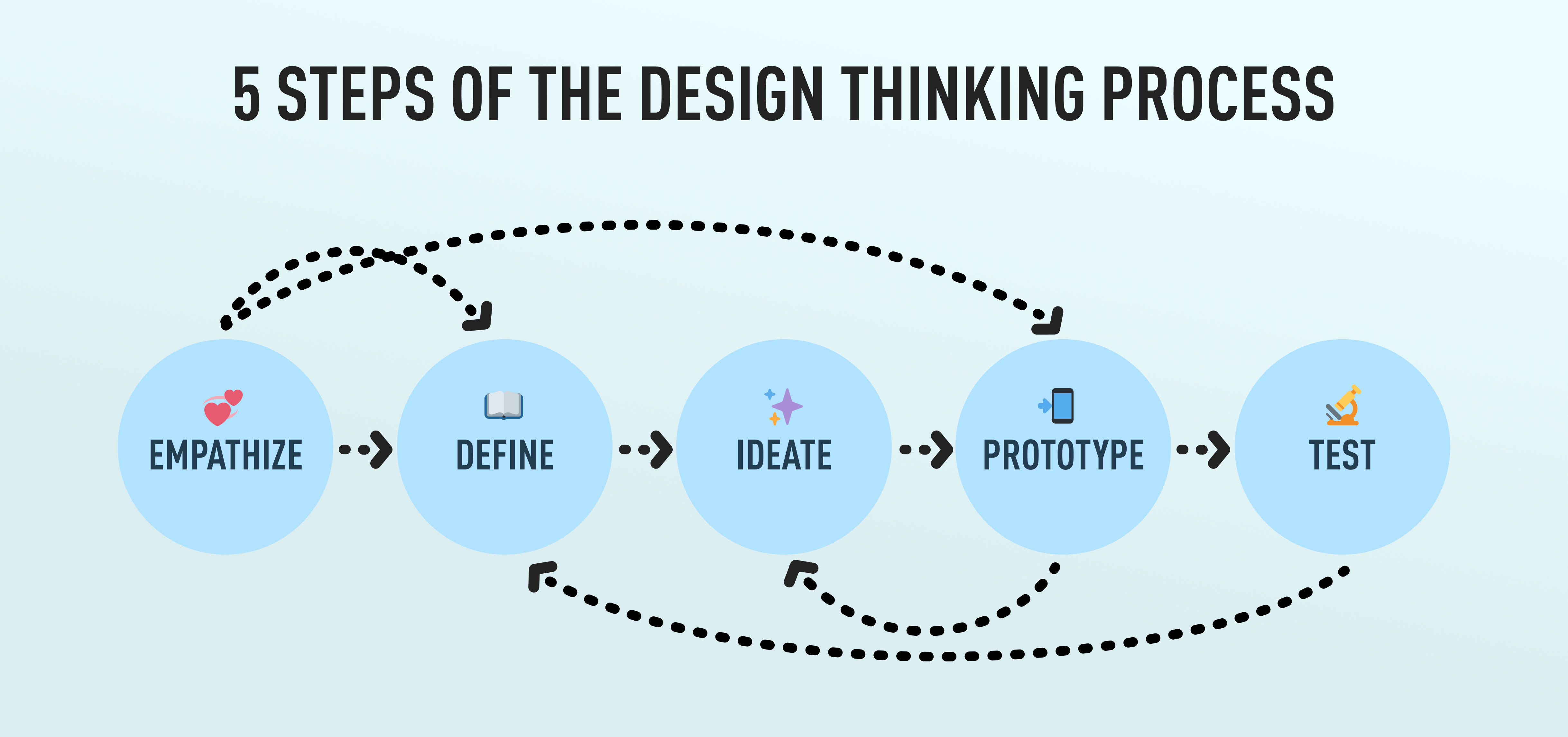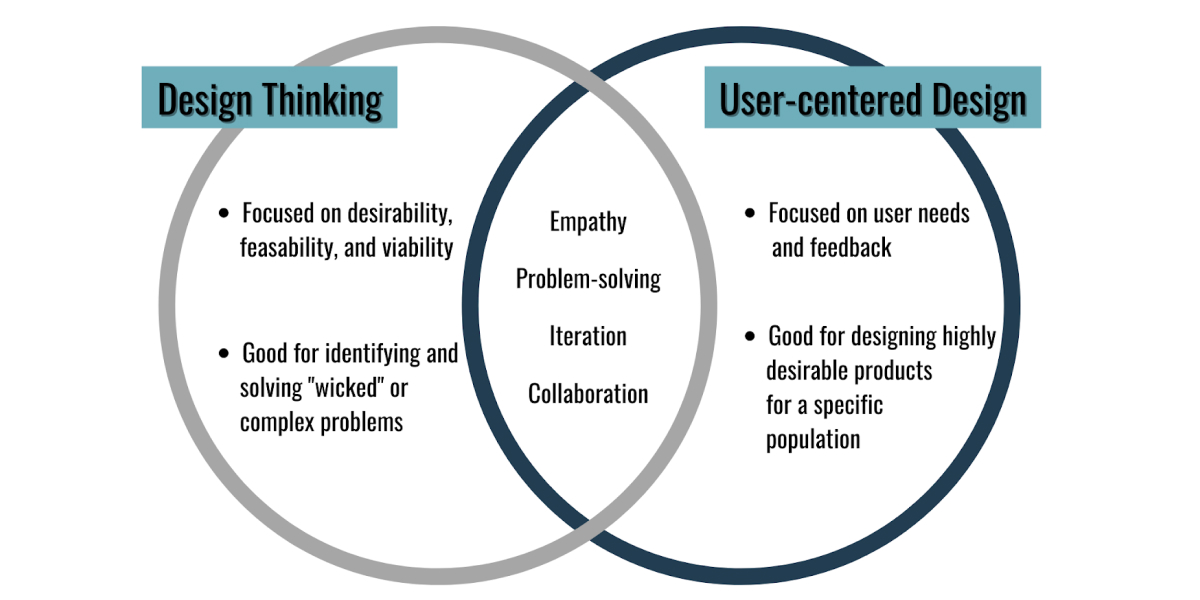Rapid growth in technology is forcing a variety of organizations to reassess their current offerings and operations in order to exchange them for more up-to-date, user-friendly options. The terms user-centered design (UCD) and design thinking (DT) are more and more frequently used by businesses, governments, design agencies, and social organizations when discussing finding solutions for both individual, consumer, and societal problems. But, what exactly do these terms mean? Are they interchangeable or are they their own unique process?
Some may argue that these design methods are one and the same, while others swear by their differences. In this article, we’ll break down what each design method is, what their similarities are, where they diverge, and when to use each.
Here’s what we’ll cover:
- What is user-centered design?
- What is design thinking?
- What are the differences between user-centered design and design thinking?
- What do user-centered design and design thinking have in common?
- Final thought
These two disciplines can be quite similar in nature, yet there are crucial distinctions to make between them. Let’s get into it!
1. What is user-centered design?
The term user-centered design was first coined in 1977 by computer scientist Rob Kling. It gained further attention and popularity as it was featured in Don Norman’s books User-Centered System Design: New Perspectives on Human-Computer Interaction (1986) and The Design of Everyday Things (1988).
In short, user-centered design is an approach to design that puts users’ needs front and center, and follows an iterative design process that focuses on the user’s needs every step of the way. While there is some focus on the requirements of the company, a majority of design decisions are made with the user’s expectations and needs at the forefront. The main goal of UCD is to create a product that is highly desirable and functional to the user.
There are five key principles that guide user-centered design and four main steps that make up the UCD process.
The main principles of UCD are:
- Early involvement of end-users
- A clear understanding of the context of use and user needs
- Regular collection, analysis, and incorporation of user feedback
- Employing a user-centric approach to product development and delivery procedures
- Utilizing an iterative design process with a continual goal to improve user experience
The four steps of the UCD process are as follows:
- Understand the user and context of use: This first step is all about researching your users’ behaviors, problems, and goals as well as how they might interact with your product.
- Specify user and business requirements: Here, you establish why the product is beneficial for both the users and the business, and find metrics to measure what success looks like to the company and the users.
- Create design solutions: Step three is all about storyboarding, journey mapping, wireframing, designing mockups and user flows, testing out different UI elements, as well as determining effective information architecture to design a product that solves users’ problems.
- Evaluate designs: Finally, you conduct usability testing (preferably with actual users) to test the effectiveness of preliminary designs, and determine what is working well and what needs improvement

Once the UCD process has been completed, there’s usually a need for multiple rounds of iteration until the design is complete and ready for release.
If you’d like to learn more about UCD, check out our user-centered design how-to guide.
2. What is design thinking?
Design was first thought of as a science or way of thinking by Nobel Prize laureate Herbert A. Simon in 1969. This concept has been accepted and expanded upon widely by a variety of designers, scholars, and practitioners over the years, but IDEO has been credited with bringing design thinking into the mainstream—they even coined their own terminology and step-by-step process.
Design thinking is a creative approach to innovation and problem-solving that takes design perspectives and processes and applies them to problems that designers don’t typically encounter.
According to IDEO, design thinking looks for solutions to “wicked” (or complex) problems that are feasible (technologically possible), desirable (to the end user), and viable (cost-effective to the business).

Design thinking is an iterative process consisting of five steps:
- Empathize: Develop an understanding of the challenges the system/users are facing through observation (ie. interviews, surveys, etc.).
- Define: Analyze data and clearly articulate the problem you want to solve.
- Ideate: Brainstorm a large quantity of diverse ideas that could serve as potential solutions to the problem.
- Prototype: Build a simulation of your ideas as prototypes to test as possible solutions.
- Test: Share and test the prototype with end-users for assessment then implement feedback into rapid iteration.
Design thinking is a non-traditional approach to problem solving and can be applied to a variety of industries to help strengthen their services, products, policies, or design processes. It can be used to develop solutions for end-users but can also help organizations reinforce innovation, boost creativity, and implement new strategies and concepts for better overall function.
If you’d like to learn more about design thinking, there are lots of books about design thinking out there, as well as design thinking exercises you can try out. You can also check out how I describe it in this video:
3. What are the differences between user-centered design and design thinking?
Since user-centered design and design thinking both help find solutions to people’s problems, you may be wondering what the big differences between these two design methods are. While the steps and general mindset of each are quite similar, the most notable difference is their primary focus.
User-centered design focuses on fostering deep empathy with the population you are designing for. The goal is to create solutions with users’ needs and feedback at the forefront of all design decisions.
User-centered design is a great approach when you want to design a highly desirable product for a specific audience.In the UCD process, the user is the focus from first ideation to development and release. Check out these great examples of user-centered design.
While design thinking also requires great knowledge of the user, it also takes technological feasibility and business goals into consideration. This is a method that can be applied to more than just product development.
Design thinking utilizes abductive reasoning to identify and solve complex problems that may affect product design or organizational policies, processes, and function. Check out these game-changing examples of design thinking.

4. What do user-centered design and design thinking have in common?
While the primary focus of these two approaches are indeed different, user-centered design and design thinking share many similar principles and concepts. Let’s take a look at what these design methods have in common.
Empathy
Empathy is key for UX designers. The ability to feel for your users and understand their behaviors as well as the challenges they face is a crucial part of any design process. So, whether you are using UCD to create a stellar mobile app or design thinking to revamp employee training, you’ll need to have great awareness of the population you are designing for and what their needs are.
Problem-solving
Both UCD and DT view problems as opportunities for improvement. Each method takes an optimistic approach to problem-solving and uses structure, action, and design to take the issue at hand and turn it into a positive experience for both the company and their users.
Iteration
The process for both UCD and DT is a cyclical one that relies on learning from mistakes and incorporating user feedback into future designs. At the end of each cycle, designers assess what went well, what needs work, and how to use past failure to generate new and improved solutions.
Collaboration
Each design method works best when a team of people across organizational silos work together. Both approaches are optimized when designers, high level executives, developers, accountants, customer-facing employees, researchers, etc., all work together towards a common goal.
5. Final thought
Both user-centered design and design thinking are invaluable resources to keep in your designers toolbox. When choosing which design method will work best for your current project, it’s important to understand the subtle variance between user-centered design and design thinking.
While they each have analogous steps and similar overarching concepts, the small differences in their main focus may make one method more preferable than the other.
However, what is clear about both UCD and DT is their empathic, collaborative, and iterative nature when solving problems for individuals, organizations, and societies at large.
If you’d like to read more about both of design thinking and user-centred design, as well as the field of UX design in general, check out these articles:
- How to Get a Design Thinking Certification: The Best Programs and Courses
- What Is Information Architecture in UX Design?
- Why Should Designers Learn to Code?
(Cover image credit: Andrea Piacquadio @ PICNOI)
